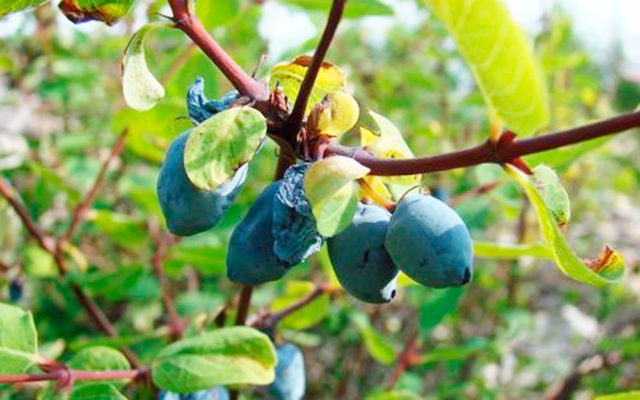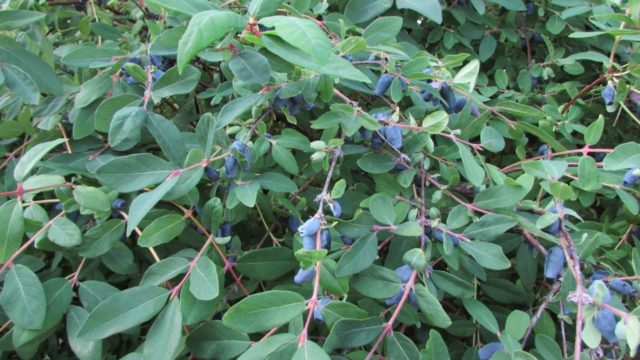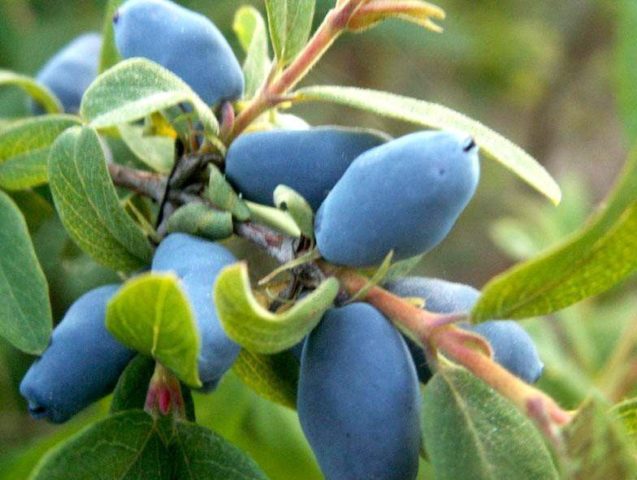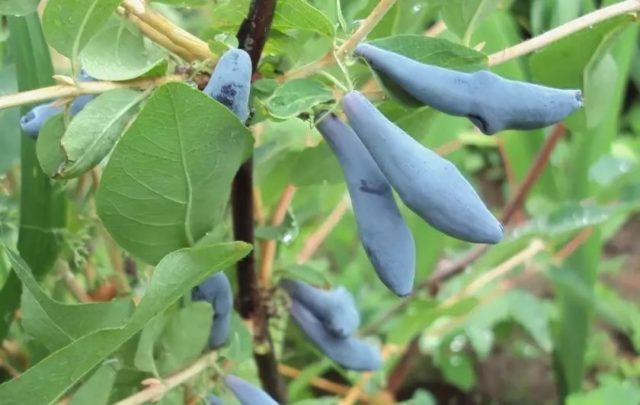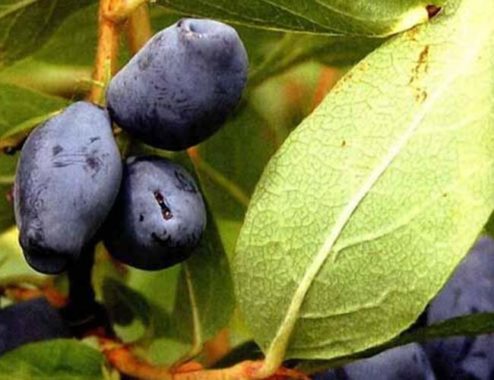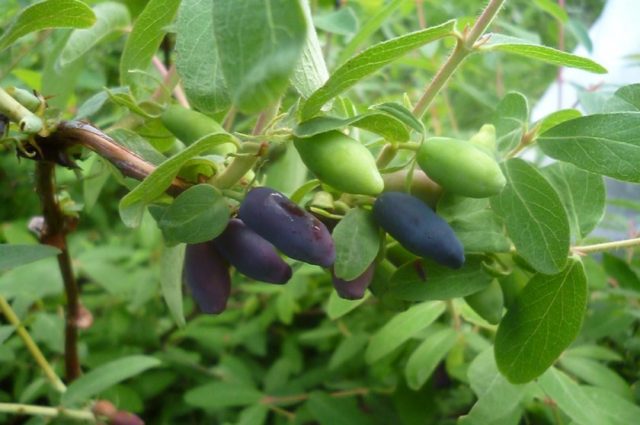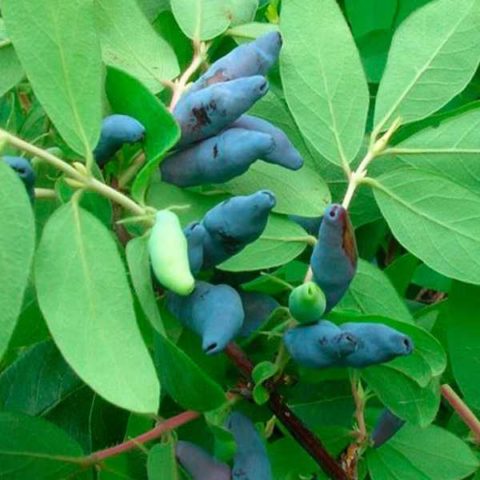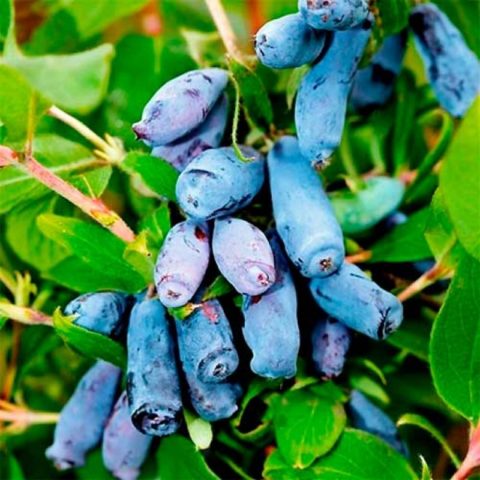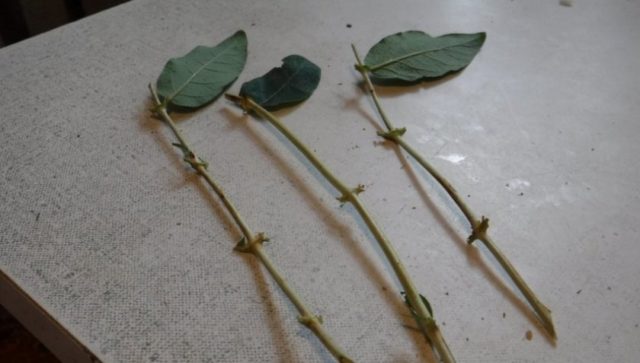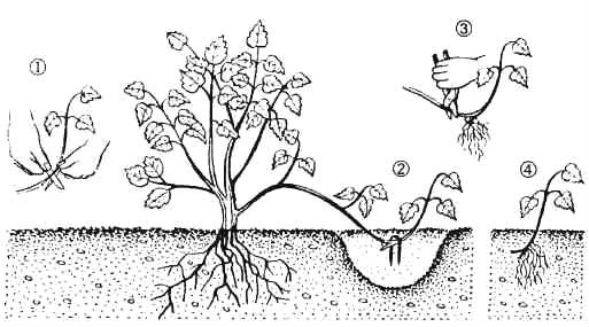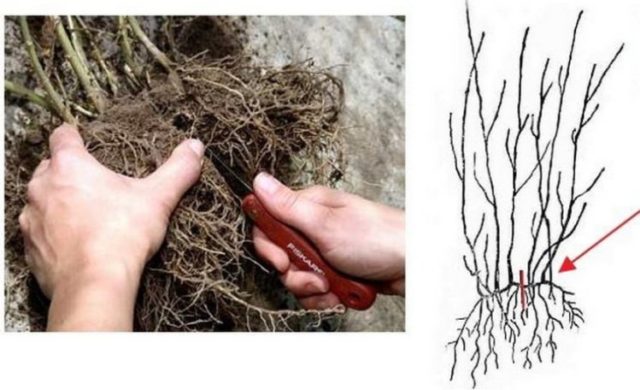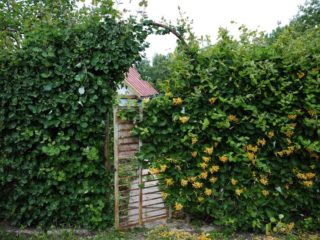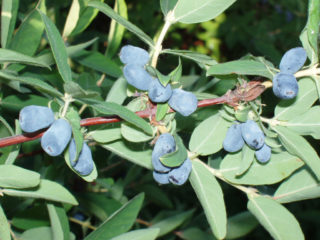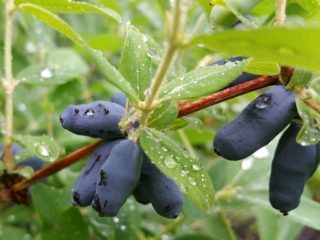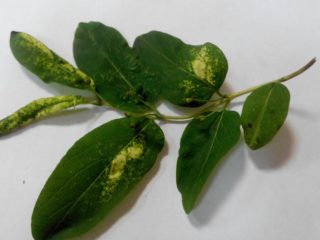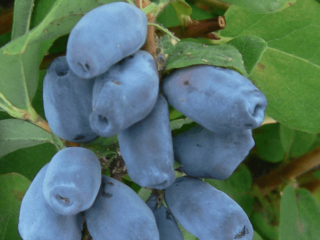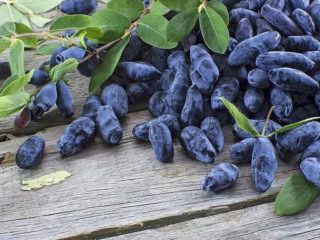Content
In many regions of Russia, including the Urals, growing edible honeysuckle is becoming more and more popular every year. This is due to the low maintenance requirements, good productivity and, most importantly, the unpretentiousness of this crop, which is capable of growing and developing well even in unfavorable climate conditions. For this reason, planting honeysuckle in the Urals is considered by many gardeners as a real alternative to the more common berry bushes.
Features of growing honeysuckle in the Urals
The Ural region has a large extent both from west to east and from north to south. Moreover, on its territory there are the Ural Mountains, which have a significant influence on the weather. All this is the reason for the strong heterogeneity of the climate of the Urals, which is influenced by the Atlantic, cold winds of the Arctic, and dry air currents from Central Asia.
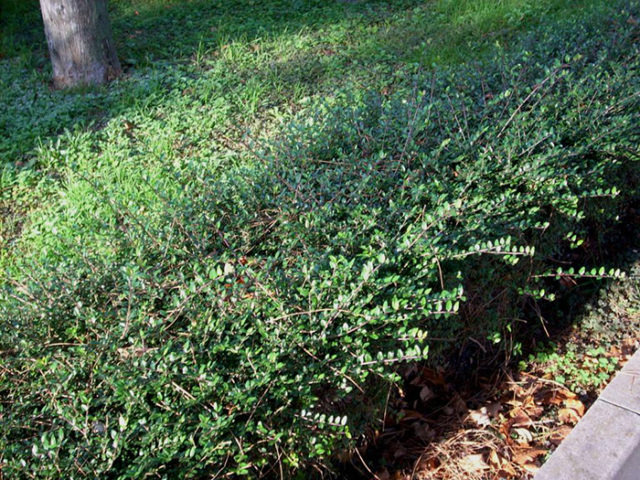
Honeysuckle grows well in the Ural climate
To grow and bear fruit in this region, plants must have the following qualities:
- Have good resistance to sudden weather fluctuations.
- Withstand return frosts.
- Tolerate periods of drought and severe frosts.
All these qualities are present in varieties of edible honeysuckle obtained from the Kamchatka and Altai varieties. It is in these regions that there are natural habitats for the growth of this shrub, therefore the resulting hybrids are most suitable for cultivation in areas with an unfavorable climate, including in the Urals. Selection work in this direction has been carried out since the middle of the last century, not only in Russia, but also in other countries.
The best varieties of honeysuckle for the Urals
Honeysuckle begins to bear fruit earlier than other crops in the season. Its early varieties in the Urals reach ripeness already in early June, and the latest - in mid-July. Thanks to this, even in the Ural climate it is possible to obtain a full harvest. Here are some of the productive varieties of edible honeysuckle suitable for growing in the climate of the Urals:
- Amazon. This honeysuckle variety is an early ripening variety; the berries reach ripeness in the 20th of June. Productivity can reach up to 1.5 kg from each bush. The berries are about 1 g, jug-shaped, medium-sized, sweet, with a noticeable bitterness in the taste.
The honeysuckle bush is slightly spreading, the shoots are rather thin, curved, medium pubescent, the leaf blades are medium-sized, lanceolate
Important! The berries of this variety do not tend to fall off. - Bazhovskaya. According to many gardeners, this is one of the best varieties of honeysuckle suitable specifically for the Urals. The bush is vigorous and can reach 2 m in height.The shoots are quite thin, curved, slightly pubescent. The leaves are dark green and quite large. The fruits weigh about 1 g, although larger ones are also found. The berries are barrel-shaped and elongated, with an uneven surface. The taste is excellent, dessert-like, without bitterness, the aroma is pronounced. Bazhovskaya bears fruit at the end of June.
Fruiting of honeysuckle is slightly extended, there is a slight tendency of the berries to shed
Important! The variety is resistant not only to cold, but also to drought. - Viola. The bushes are large, spreading, up to 2 m high and with a crown diameter of up to 2.5 m. The shoots are strong, smooth, and pubescent. The variety begins to bear fruit in the Urals around mid-June. The berries are oval-elongated, dark blue, with an average weight of about 1.1 g. The taste is not the brightest, sour-sweet, with a slight bitterness. Productivity up to 4 kg.
The tendency of honeysuckle to shed is weak
- Bakchar's pride. The bush is not very tall, up to 1.5 m, visually reminiscent of a haystack. The shoots are long, curved, and due to their chaotic arrangement, the bush often looks sloppy. This is one of the largest-fruited honeysuckle varieties for the Urals; the berries are distinguished by their large size. The length of the fruit can reach up to 5 cm and weight up to 1.7 g. The shape of the berries resembles a slightly curved spindle; they are blue-violet in color with a dense bluish coating. The taste is excellent, according to various tasting scores from 4.7 to 5 points.
The berries lie well and are transported
A video about the honeysuckle variety Pride of Bakchar can be viewed at the link:
Important! The variety has a tendency to shed. - Gorlinka. Mid-season variety, ripening in the Urals by the end of June. The shoots are thin, often drooping, forming a medium-spreading bush in the shape of an inverse cone.The berries are large, pitcher-shaped, purple with a bluish coating. The tendency to shedding is weak. The average weight of berries is 1-1.2 g, the yield is about 1.5 kg.
The taste is excellent, the fruits are sweet, without bitterness
- Maria. Ripens in the Urals in mid-June. Bush 1.2-1.5 m high, medium density. The shoots are smooth, of normal thickness, slightly pubescent. The berries are barrel-shaped, elongated, dark blue, weighing about 0.9 g. Productivity 2-2.2 kg.
The fruits have an excellent taste and do not fall off, but due to their thin skin they have poor shelf life and transportability.
- Tomsk Bush 1.5-1.8 m in height, compact, medium spreading. The shoots are smooth, rather thin, usually bending towards the ground. The drop-shaped shape of the berries is the hallmark of this variety. The fruits are dark, purple-black, covered with a dense bluish coating on top, weighing up to 1 g. Fruiting in the Urals begins in the first half of June, it is extended over time, and due to the tendency of the berries to shed, it is necessary to harvest in several stages.
The average yield is about 2 kg, in a good year it can increase to 3-3.5 kg.
- Chelyabinsk. The bush is low-growing, about 1 m. The branches are thin, even, slightly pubescent. The crown is spherical and dense. The berries' resistance to shedding is good.
The taste is not bad, tasting score 4.5 points
The list of varieties suitable for the Urals is not limited to the listed species. Before choosing honeysuckle for planting, you need to study the experience of other gardeners, consult with experts, and read specialized literature. This will help you make the right choice and will greatly increase your chances of getting a good harvest, even in such a harsh region as the Urals.
Planting and caring for honeysuckle in the Urals
The agricultural technology of honeysuckle in the Urals is almost no different from similar work, for example, in Siberia or in the North-Western region. This crop does not require serious agricultural technology, however, for its successful cultivation, certain conditions must be observed.
When to plant honeysuckle in the Urals
The best time for planting edible varieties of honeysuckle in the Urals is considered to be autumn. However, winter can come to the northern regions quite early, and then the young plant may simply not have time to acclimatize in a new place. Therefore, in the fall in the Urals, only those seedlings are planted that previously grew in containers and were removed from them with an earthen lump on the roots.
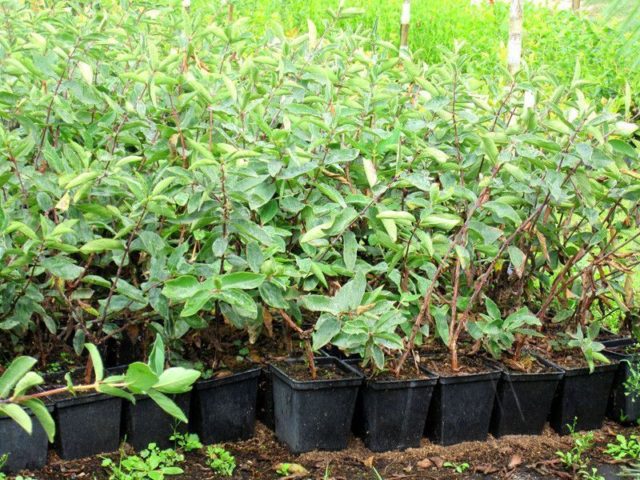
Honeysuckle seedlings with ZKS can be planted in the fall
If the roots are open, then in the Urals such honeysuckle should be planted in the spring, after the ground has thawed and warmed up a little.
Selection and preparation of a landing site
To plant honeysuckle in the Urals, you need to choose an open, well-lit area, protected from the north wind. This shrub should not be planted in lowlands where water accumulates or where cold air flows. The place should be flat or slightly elevated. The groundwater level should not be higher than 2 m, since the root system of honeysuckle is sensitive to excess moisture and can rot. The soil on the site should be loose and well-drained.
The size of the plot on which the young seedlings are to be planted is also important. Honeysuckle is self-sterile and requires pollinators to produce a harvest. It is recommended to plant at least 4 different varieties in the neighborhood with approximately the same flowering period, only in this case the harvest can be good.At the same time, mature honeysuckle bushes will occupy quite a significant area on the site.
Rules for planting honeysuckle
Planting pits for honeysuckle seedlings must be prepared in advance. Their size is determined by the size of the root system of the transplanted plants or the size of the container in which they are located. A layer of drainage made of broken brick, expanded clay or small crushed stone is poured onto the bottom.
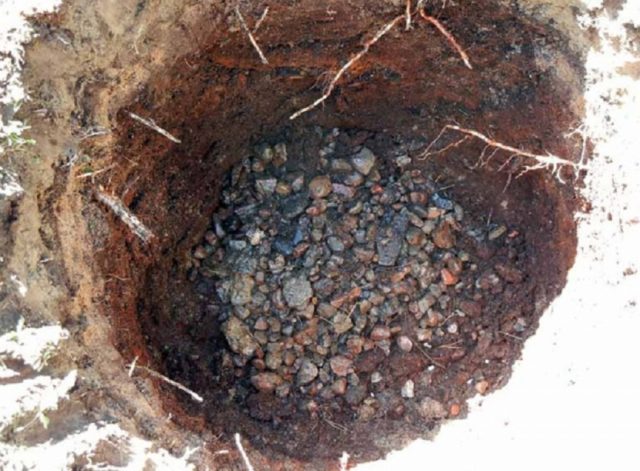
Drainage will save you from excess moisture in the roots
The soil is mixed with humus, and a small amount of mineral potassium and phosphorus fertilizers, as well as wood ash, are added to improve its properties. If the soil is dense loam (which is not uncommon in the Urals), then you should definitely add sand. A honeysuckle seedling removed from the container, together with a ball of earth on its roots, is placed vertically in a hole, the voids are filled with soil substrate, periodically compacting it.
If the roots of the honeysuckle are open, then before planting, you need to pour a pile of earth at the bottom of the hole. A seedling is placed on it and the root system is gradually covered with nutrient substrate, slightly compacting it. After filling the planting hole, intensive watering is carried out, and the root zone is mulched to retain moisture.
Watering and fertilizing
Honeysuckle loves water, but its stagnation in the roots has a negative effect on the plant. Therefore, water this shrub moderately. If there is a lack of precipitation, watering is carried out once a week, while the consumption rate per bush is approximately 10 liters.During drought, which often occurs in the Urals, the amount of water is doubled; this must be especially carefully monitored during the period of berry formation. A lack of moisture during this period can lead to the fact that honeysuckle begins to drop unripe fruits, which will negatively affect the yield.
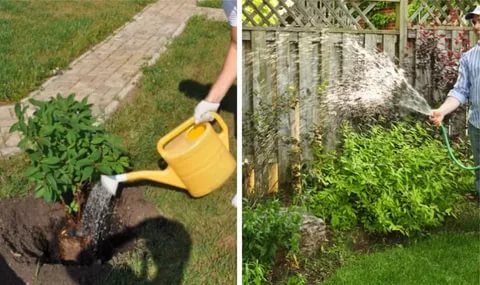
Honeysuckle needs to be watered regularly, but in moderation.
Edible honeysuckle is fed several times a season:
- In early spring - urea or ammonium nitrate, 25-30 g of fertilizer is diluted in 1 bucket of water and poured under the root.
- In mid-summer, at the end of the harvest, 1 bucket of rotted manure or humus is added under each bush.
- At the beginning of autumn, potassium salt (15-20 g) and superphosphate (25-30 g) are added to the root zone.
Trimming
In the first years, honeysuckle intensively forms new shoots, and without pruning, the bushes often become shapeless and unkempt. To prevent this from happening, you need to periodically cut out excess shoots from the bush. The following types of pruning are distinguished:
- Sanitary. It involves removing dry, broken, damaged and diseased branches.
- Thinning. Thickening shoots are removed and the center of the honeysuckle bush is lightened for better fruiting.
- Rejuvenating. Honeysuckle shoots older than 8 years, which produce weak annual growth and do not bear fruit well, are gradually cut out, replacing them with younger ones.
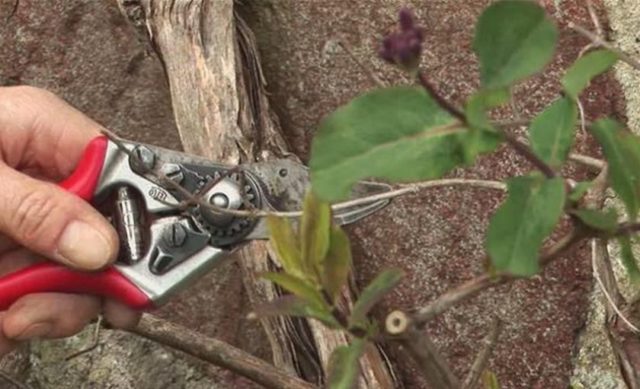
Pruning is an important part of honeysuckle care.
How to prepare honeysuckle for winter in the Urals
Honeysuckle is one of the most frost-resistant crops, able to easily tolerate frosts down to - 35-40 ° C, and some varieties can withstand temperatures down to + 50 ° C. With such frost resistance, as a rule, no measures are taken to prepare for winter in the Urals. You need to pay attention only to the youngest seedlings that have just been brought into open ground. They can be covered with spruce branches.
Honeysuckle propagation
Honeysuckle can be grown from seeds, but seedlings do not retain varietal characteristics. To obtain a complete analogue of the variety you like, the following vegetative methods are used in the Urals:
- Cuttings. You can root both lignified cuttings, doing the work in winter, and green ones, which are cut from annual growth. Cuttings can be rooted both in soil and in water.
Cuttings are a quick way to propagate honeysuckle
- Reproduction by air layering. In the spring, one of the side shoots of the honeysuckle bush is bent to the ground, fixed and covered with soil. Gradually the branch takes root and sprouts its own sprouts. A year later, after the shoot has overwintered along with the mother bush, it is cut off and transplanted to a new place.
Air layering is very easy to obtain
- Dividing the bush. If the honeysuckle is older than 8 years, then it can be dug up and divided into several parts using a knife or ax so that each division has its own shoots with roots. After dividing, parts of the bush should be immediately planted in the chosen location.
Only mature honeysuckle bushes can be divided
Diseases and pests
Honeysuckle gets sick very rarely, and its diseases are associated primarily with improper planting or poor care, for example, with excessive watering, too much fertilizer, or too much pruning. Among the pathologies on the shrub, various spots on the leaves may appear, resulting from the appearance of fungi, as well as root rot, which occurs due to an excess of water in the root zone.
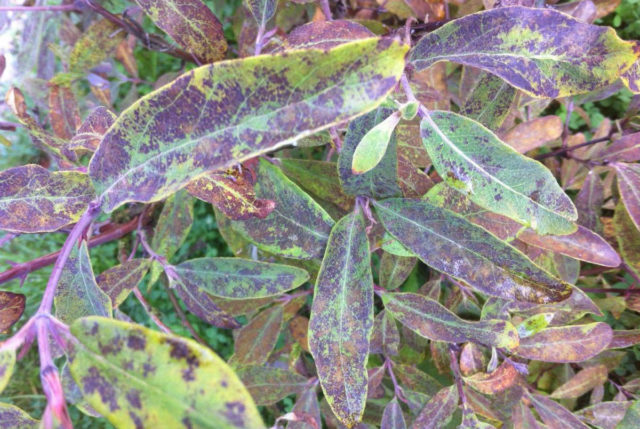
Spotting is the result of damage to shoots and leaves by fungi
Fungal diseases are treated by spraying the bushes with various fungicides, for example, Bordeaux mixture. Treatment of honeysuckle with the same preparation for prevention is one of the care measures; in the Urals this is done at the very beginning of spring, before the start of the growing season.
Pests also appear on this shrub quite rarely. The development cycle of many of them simply does not coincide with honeysuckle, which blooms and bears fruit very early. However, on some varieties, the appearance of aphids - microscopic sucking insects - is sometimes observed. Due to its fertility, the colony of this pest can increase many times over in a short time, and this leads to the fact that the shoots begin to lack nutrients, the leaves on them wither and fly off, which is why the entire honeysuckle bush suffers.
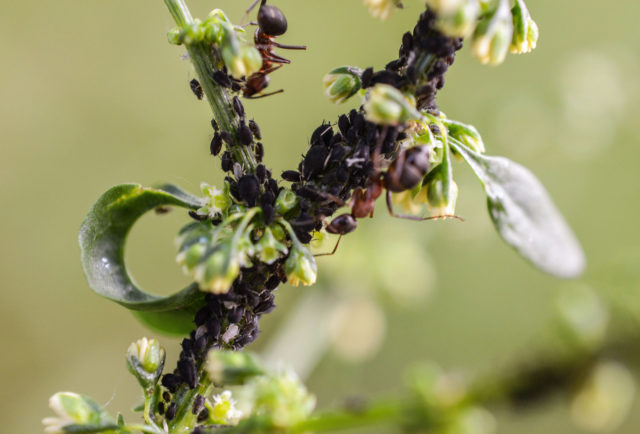
Aphids are a common garden pest.
They fight aphids using insecticides or folk remedies, for example, infusions of tansy or garlic.
Conclusion
Planting honeysuckle in the Urals is a good way to diversify the range of garden crops.Due to its unpretentiousness, this species is suitable for cultivation not only by experienced, but also by novice gardeners, and its amazing frost resistance is the key to successful growth even in this region, which is not the most suitable for gardening. The undoubted advantage of honeysuckle is that its fruits are not only tasty, but also healthy, it contains vitamins, microelements, as well as other substances necessary for human health, and this is very important for such a region, which is not entirely safe in ecological terms, like the Urals .
